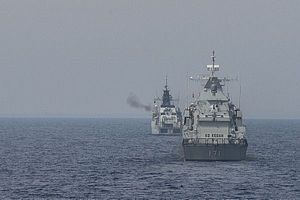Last week, Indonesia, Malaysia, and the Philippines wrapped up a joint land patrol exercise. The engagement, a long-mulled step within trilateral collaboration between the three countries, represents the ongoing development of a key manifestation of minilateral security collaboration in Southeast Asia.
As I have noted before in these pages and elsewhere, one of the most important developments in minilateral collaboration in Southeast Asia in recent years has been the advancement of trilateral cooperation between Indonesia, Malaysia, and the Philippines. Following intensifying discussions after a spate of kidnappings of nationals by militant groups in mid-2016, collaboration took shape as the Trilateral Cooperative Agreement (TCA) in 2017 and into 2018, with maritime and air patrols and the setting up of hubs for operations in each country.
One of the aspects that had been closely watched regarding TCA’s expansion had been the addition of a ground component to complement the maritime and air elements. While conversations had continued on this front through 2018, the idea began to pick up momentum this year, with Indonesian Defense Minister Ryamizard Ryacudu announcing at the Shangri-La Dialogue (SLD) in Singapore in June 2019 that there would finally be the holding of a month-long joint land exercise in Tarakan in North Kalimantan.
Last week, the Sulu Sea trilateral patrols were in the headlines again with the completion of a land exercise within the framework of the Sulu Sea trilateral patrols. The joint training exercise, named the Indomalphi (shorthand for Indonesia, Malaysia, and the Philippines) Middle Land Exercise 2019, opened on July 29 and had its closing ceremony in Tarakan, North Kalimantan on August 7.
According to the account provided by Indonesia’s defense ministry (KEMHAN), the exercise saw representatives from the armies of all three sides participate, with the aim of enhancing border cooperation to counter a range of transnational crimes including terrorism as well as to contribute to general peace, security, stability, and economic progress in all three countries. Earlier remarks from the Indonesian defense ministry in June before the exercise kicked off had said that each country would deploy a company of troops and a few observers, with drills including training on areas such as shooting and close-range combat.
According to a statement on the exercise at the closing ceremony read by the inspector general of Indonesia’s defense ministry, Didit Herdiawan, representing Indonesia’s Defense Minister Ryamizard Ryacudu, the exercise had been beneficial in exchanging knowledge and skills in handling the terrorism threat, building friendship and trust between the armed forces of the three countries, and enhancing deterrence against threats. The statement also noted that the strategic value of the development of Sulu Sea trilateral cooperation had broader strategic value for the security and stability of Southeast Asia more generally.
To be sure, without much in the way of additional details offered such as personnel numbers and the specific types of interactions involved, it is difficult to evaluate the extent to which the exercise constitutes progress within the building out of Sulu Sea trilateral collaboration between the three countries. And as Ryacudu’s statement noted and consistent with some of his other recent remarks on the subject, there is still much more that needs to be done in order to develop the knowledge, skills, and communication between all three sides to a level that would translate to operational significance on the ground. Indeed, the idea of the exercise was initially to focus on familiarizing each side with their capabilities as well as the terrain for potentially more complex and involved engagements further down the line.
Nonetheless, the further development of the ground component of Sulu Sea trilateral cooperation as well as the expansion of related mechanisms more generally deserve emphasis. Given the seriousness of the challenges these countries face as well as the attention this minilateral security mechanism has received from both within Southeast Asia as well as among major powers, how things evolve on this front will be key to watch in the months and years to come.
































